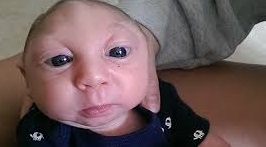


When a baby is born without brain, this is a medical condition known as anencephaly. Anencephaly is one of the neural tube defects like spina bifida but it occurs on the brain end of the spinal cord and not on the butt end. Many anencephalic pregnancies end in a miscarriage, so you don't see it often in full term babies. Nearly every baby with anencephaly will die around the time of birth. According to the CDC about 1 in 5000 births will involve an anencephalic baby. Although this is highly lethal, a Florida boy, Jaxon Emmett Buell, who lost most of his skull and brain at birth has celebrated his 1st birthday and has learnt to say simple words like "mama" and "daddy". Let's pray for this little boy and at same time know more about this cruel and heartbreaking disease.

If a baby is born without brain, this is a serious congenital anomaly. The baby's skull is partially missing and much of the brain fails to develop. It is considered the most severe form of neural tube defect.
These are the most common findings in an anencephalic baby; however, not every baby will have all of these signs below:
There is no available treatment for anencephaly and the baby will soon die. The baby can be supported by being kept warm and by protecting the part of the brain that has become exposed to the air. The baby may also be fed with a special bottle to give it some nutrition to support its life.

This is a birth defect that occurs very early in the pregnancy, usually in the first month. This is when the woman usually doesn't even know she is pregnant. The neural tube is supposed to close early on in pregnancy and this helps create the brain and skull of the baby, the bones of the upper spine, and the spinal cord.
If the upper portion of the neural tube isn't able to close, anencephaly is the result. No one knows why this happens in some babies and not in others, but the end result is a baby born without brain. The forebrain is missing and the part of the brain associated with thought and coordination are absent. What part of the brain that does exist usually doesn't have any kind of bony or skin covering.
There are some risk factors that predispose a baby to fail to close the neural tube, resulting in an anencephalic baby. Here are some factors to consider:
There are different ways to detect anencephaly. Here are some ways:
 Anencephaly can be partially prevented by eating foods that supply proper nutrition and by taking a prenatal vitamin even before you get pregnant. It is vital that you get enough folic acid before getting pregnant. Supplements are usually required because there usually isn't enough folic acid in the food we eat.
Anencephaly can be partially prevented by eating foods that supply proper nutrition and by taking a prenatal vitamin even before you get pregnant. It is vital that you get enough folic acid before getting pregnant. Supplements are usually required because there usually isn't enough folic acid in the food we eat.
Foods that can help deliver folic acid include dried beans, oranges, leafy green vegetables and orange juice. You can also eat fortified foods with folic acid. Synthetic folic acid is better absorbed than the folic acid you get in the foods you eat. It is required that all cereal products be fortified with folic acid by the US FDA.
If you have had an infant with a neural tube defect, the doctor may have you take greater amounts than most people throughout the pregnancy. Ask the doctor about how much folic acid you should take. In women who have had a neural tube defect baby, it is estimated that 4 milligrams of folic acid be taken at least 2 months prior to becoming pregnant again.